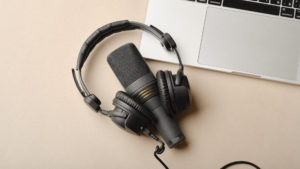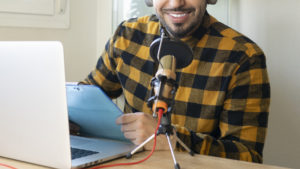The Shure SM7B is an incredibly popular microphone in the podcasting world, and for good reason. Its reputation among podcasters and professionals in the entertainment industry is highly regarded calling it the best microphone for podcasting, thanks to the extensive research and development that Shure has poured into this exceptional piece of audio equipment.
Whether you’re a podcaster, streamer, voiceover artist, or someone who just needs a high-quality microphone for your Zoom meetings, the SM7B delivers outstanding results. Its professional sound quality and affordability make it an attractive option for both newcomers and seasoned veterans in the podcasting community.
In this comprehensive Shure SM7B review, we delve into the features and benefits of this popular podcasting microphone. We also discuss a few minor drawbacks, helping you make an informed decision about whether it’s the right fit for you.

Discovering the Perfect Mic
Discovering the ideal microphone is an exciting adventure, comparable to finding the perfect glove or shoe. It involves careful research, experimentation, and attention to detail. However, when you finally come across that perfect match, it’s like a beautiful symphony, as it elevates your voice and magnifies your message with impeccable clarity. Therefore, it’s essential not to compromise on excellence when it comes to capturing your sound. Keep exploring, keep trying different options, and before you know it, you’ll find the microphone that feels tailor-made for you.
To discover the perfect fit, it is crucial to explore and experiment with a variety of options. Embrace the opportunity to step into new territories and welcome the unknown. The path of exploration is full of delightful surprises, leading you to the option that truly resonates with you. Stay open-minded and enjoy the adventure of finding the ideal match.
We strongly encourage considering multiple options and testing them before making a final decision. This allows you to thoroughly assess each option and identify the ones that do not meet your needs. By taking this approach, you can make a well-informed choice and avoid wasting your valuable time and money on products that are not suitable for you.
The Brilliant Design of Shure SM7B
The design of the Shure SM7B is both sleek and sturdy. It shares its lineage with the well-respected Shure SM57 and was introduced in 2001 as an upgrade to the original SM7. The dense and chunky housing, made of enamel aluminum and steel, feels substantial and durable in your hands. The XLR microphone hangs from an integrated yoke, featuring a three-pin XLR jack and a threaded nut for easy mounting. The back of the microphone includes control buttons, including switches for low-frequency roll-off, mid-frequency boost, and a flat response.
The housing of the SM7B incorporates several useful features that contribute to its clear and reliable performance, including shielding from electromagnetic hum, a vibration isolator, air-suspension shock mount, metal grill for capsule protection, and a double windscreen. Its durability is particularly noteworthy, ensuring that the microphone can withstand accidental drops without compromising its functionality.
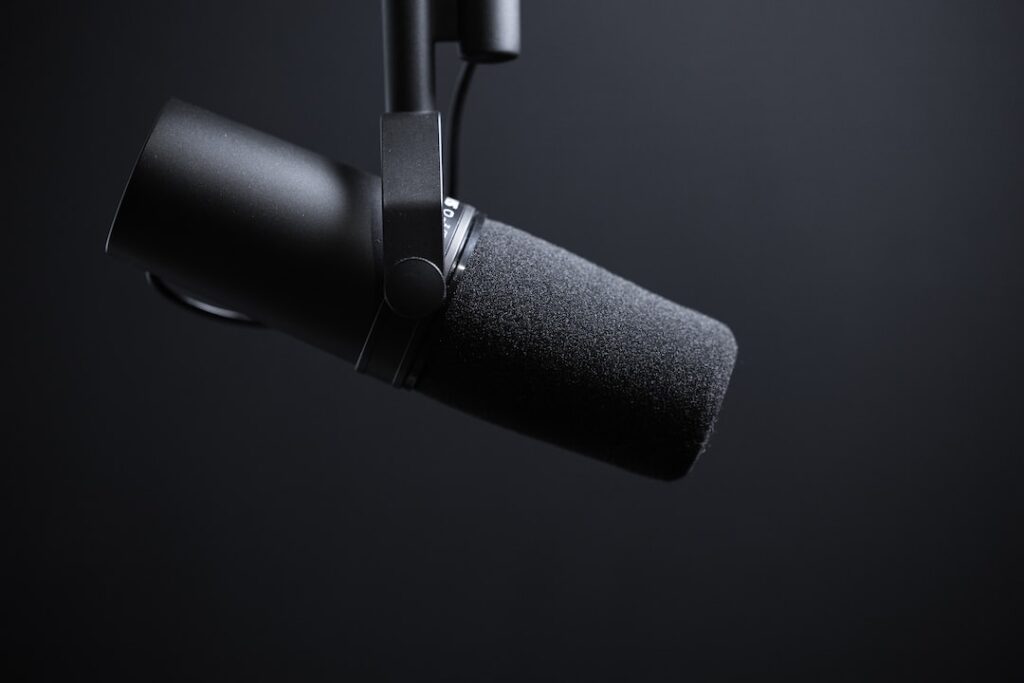
Key Features of the SM7B
One of the key features of the SM7B is its ability to produce high-quality sound, even for non-audio engineers. It captures the entire audible spectrum from 20 Hz to 20,000 Hz, making it suitable for a wide range of vocals and music. Additionally, the two EQ switches on the back of the microphone allow for sound customization. The low-cut switch filters the spectrum around 400 Hz, while the mid-boost switch enhances the response between 900 Hz and 11,000 Hz. These switches are valuable tools for reducing rumble from resonant sources, and experimenting with them can greatly improve your sound.
Another notable feature of the SM7B is its double windscreen, which effectively minimizes plosives and air bursts. While you have the option to remove the foam blacks if you’re recording instruments that don’t produce air bursts, it is recommended to keep them on when podcasting.
Overall, the Shure SM7B is a top-notch microphone that delivers professional sound quality without the need for extensive audio engineering knowledge. Its range of features, durability, and customizable sound make it an excellent choice for podcasters and musicians alike.
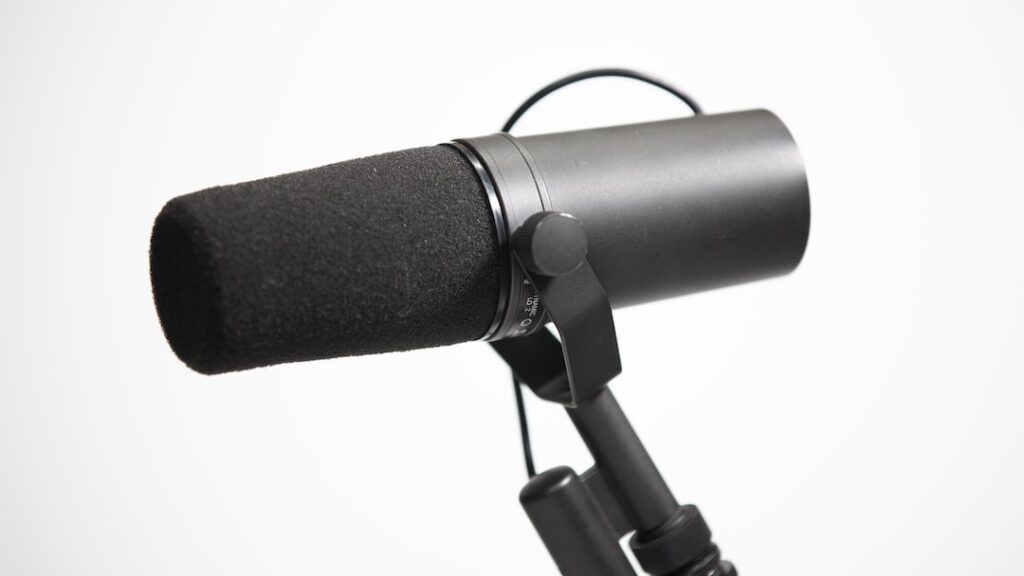
Making the Most of the Shure SM7B
The Shure SM7B is compatible with most audio equipment using a standard XLR cable, making it a convenient choice for podcasters. However, it’s important to note that this microphone requires an audio interface to connect to your computer, rather than a direct USB connection. Two highly recommended options for audio interfaces are the Focusrite Scarlett 18i8 USB Audio Interface and the Focusrite Scarlett 2i2 3rd Gen USB Audio Interface. For those willing to invest, the Rode RODECaster Pro Podcast Production Studio is an excellent choice.
Unlike some other microphones, the SM7B may benefit from additional clean gain in order to deliver a high-quality audio signal. If your preamps are not powerful enough, you may experience a quieter or potentially noisier signal. In these instances, the Cloud Microphones Cloudlifter CL-1 Mic Activator can serve as a helpful gain booster.
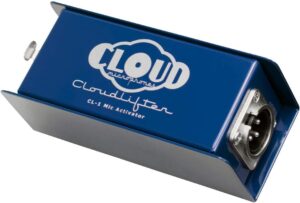
The setup process for the SM7B is fast and effortless. The threaded nut guarantees a stable connection to a boom arm or mic stand, and the conveniently placed XLR output eliminates the requirement for a separate mounting clip. This level of convenience is extremely beneficial.
Properly mounting the SM7B on a microphone stand or boom arm is crucial for optimal performance. This microphone is not intended for handheld use, so it’s important to avoid any unnecessary movement that could result in unwanted electrical noises or popping sounds in your recordings.
Immersing in the Wonderful Sound of the SM7B
In terms of sound quality, the SM7B provides a delightful, velvety, and opulent audio reproduction, all thanks to its robust coil design. Unlike fragile condenser microphones, it boasts enhanced durability and reduced sensitivity. However, it may exhibit a slight mellowness in the mid-range. To customize the sound to suit your voice perfectly, we suggest exploring the EQ switches conveniently located on the microphone’s rear.
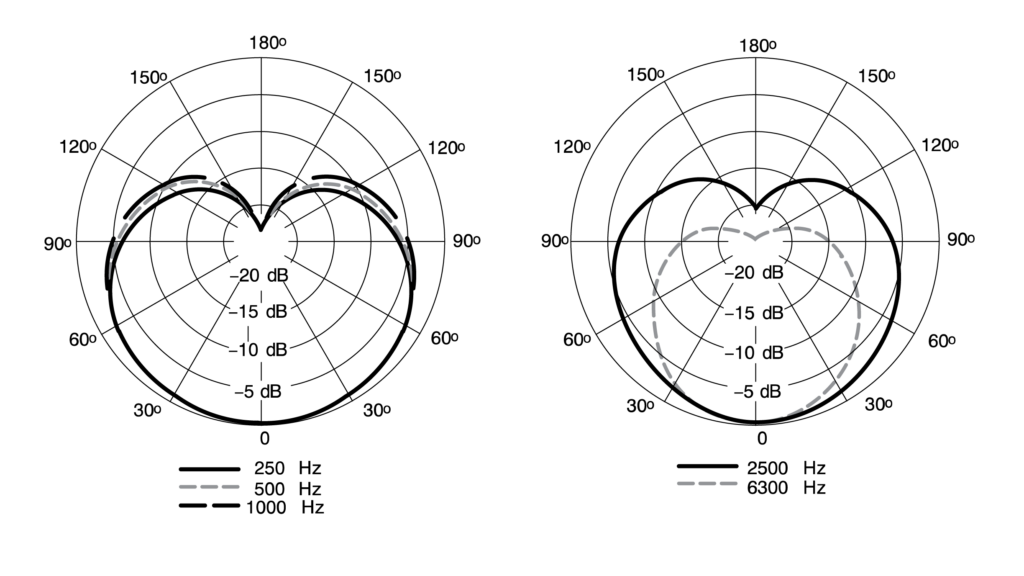
Cardioid Polar Pattern of the Shure SM7B
The Shure SM7B features a dynamic cardioid polar pattern, meaning it captures sound from the front and sides while minimizing sensitivity to loud noises. This pattern reduces audio clipping and signal distortion caused by sudden bursts of sound.
It’s essential to understand that the SM7B’s cardioid pickup pattern is designed to capture sound selectively. Placing the microphone directly in front of your mouth allows for optimal sound capture, while disregarding any off-axis noise. While it may not be the best choice for recording multiple individuals unless they are nearby, you can easily angle the mic away from background noise sources to ensure high-quality recordings. With this the Shure SM7B is considered one of the best microphone for co-hosted podcasts.
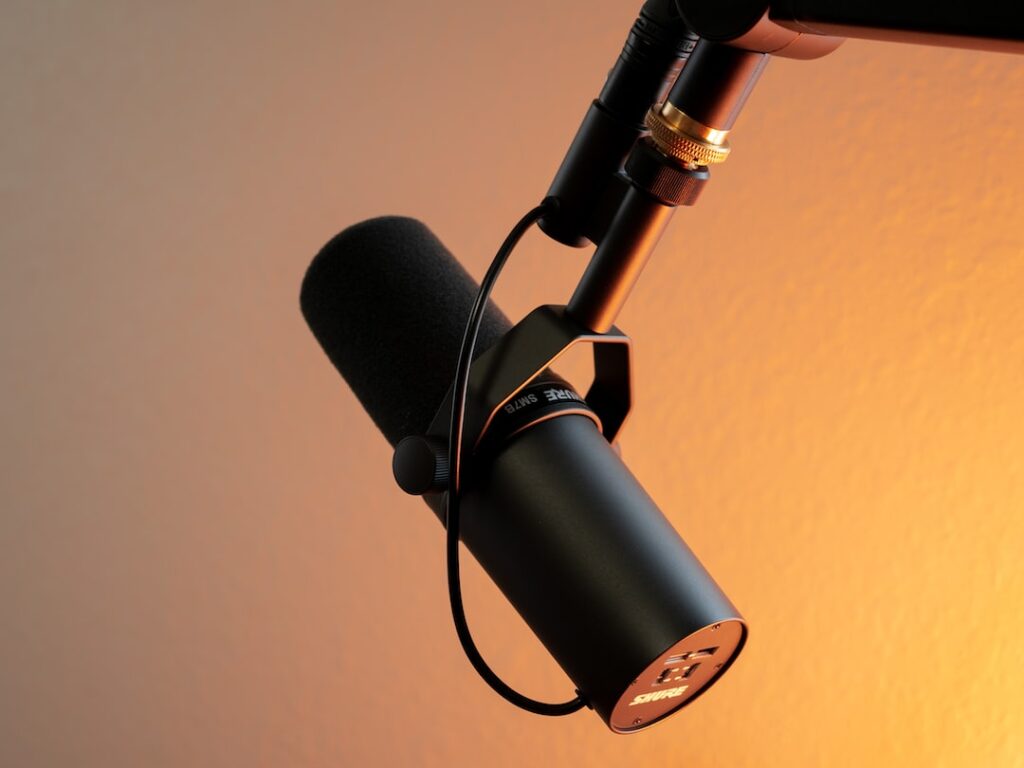
Is the Shure SM7B Worth Buying?
Are you considering buying the Shure SM7B? Whether you’re a new podcaster or a seasoned one, the Shure SM7B is an excellent choice. It offers durability, versatility, and consistency. With its well-earned reputation for quality and reliability, it has gained a massive following among audio enthusiasts. The best part is that it’s affordable, usually falling within the budgets of most serious podcasters, priced at $399.
To sum up, I enthusiastically endorse the SM7B for all podcasters. I am actually the proud owner of two of these incredible microphones. One was acquired 5 years ago, while the other has been with me for a remarkable 20 years. The durability and craftsmanship are so impressive that it’s nearly impossible to tell them apart. It’s no wonder that I included the SM7B in our list of recommended podcasting equipment, which inspired me to write this positive Shure SM7B review.
If you’re not ready to invest in an SM7B or prefer a USB interface, you might consider its little brother, the Shure MV7 ($249). It’s a compact microphone that’s more portable, making it ideal for podcasting in different locations or for those who frequently move between home and studio.
With the Shure MV7, you can record both XLR and USB outputs simultaneously. This allows you to preserve a high-resolution audio file from the XLR output and a lower version from the USB output. Depending on your final product, you may opt for the lower resolution version to save storage space. (Although, if you use Castos, you get unlimited storage!)
While the audio quality of the Shure MV7 may not match that of the Shure SM7B, it still delivers clear vocals and is easy to control with the ShurePlus MOTIV desktop app. It even offers various presets if you prefer not to customize the settings.
For those on a tighter budget, we recommend the Audio Technica ART2100x ($99). This dynamic mic is perfect for beginners, providing more forgiveness for imperfect recordings and a solid depth of voice at an affordable price. It can be connected using XLR cables or USB, depending on your setup.
The Shure SM7B is a highly acclaimed dynamic moving-coil microphone, perfect for capturing the rich detail of instruments and vocals in recording and broadcast studios. This microphone has been meticulously crafted and refined over many years, resulting in a reliable and robust design. Offering a balanced and seamless frequency response, the SM7B ensures a consistently pristine and top-notch audio quality, establishing its reputation as a go-to choice in the broadcasting industry.
Concluding Thoughts on the Shure SM7B
In conclusion, this Shure SM7B review highlights a well-constructed microphone that draws on decades of audio experience to provide reliability and clear recordings. The materials and yoke mounting system are durable and user-friendly. It even includes a built-in pop filter, eliminating the need for an additional one. The sound quality is rich and smooth, and the microphone excels at capturing your voice while ignoring any unwanted noise. Overall, we believe the Shure SM7B is a superb microphone for both new and experienced podcasters and is considered one of the top podcasting mics for beginners or experts alike.
For more on XLR microphones, check out THE ADVANTAGES AND DISADVANTAGES TO XLR MICROPHONES FOR PODCASTING.



